Unit - 10B
Ecology
An ecosystem, isa term very often occurring in biology, for a given area ecosystem is a community of plants and animals interacting with each other and with their non-living environment. The non-living environmental factors include sun, weather, soil, earth, soil, climate and atmosphere. The ecosystem highlights the way in which all the various types of organisms live close to each other and how the y is capable of interacting with each other.
“An ecosystem is an interacting system that consists of a community of living organisms in connection with the non-living components of their environment (things like air, water and mineral soil), The nutrient cycles and energy flows are linked togetherwith the components of biotic and abiotic factors. As ecosystems are defined by the network of interactions that occur among organisms, and between organisms and their environment, the organism can be of any size but usually occupy specific, limited spaces (although some scientists believe that the entire planet is an ecosystem).”
Ecosystem Structure
At a basic functional level, ecosystem generally plants which are the primaryproducers, these plants arecapable a process called Photosynthesis where harvesting energy from the sun takes place. This energy thus formed then flows through the food chain. Next after the producers come consumers. Consumers can be primary consumers (herbivores) or secondary consumers (carnivores). These consumers feed on the energy captured by the plants. Decomposers are present at the bottom of the food chain. Dead tissues of plants and animals and waste products are produced at all levels. Decomposers Scavengers, detritivores not only feed on this energy but also help in breaking organic matter back into its organic constituents. It is the microbes that play an important role in decomposition and produce organic constituents that can again be used by producers.
The energy that flows from the producers to the consumers and then to decomposers in the food chain is always inefficient. however, the amount of energy that flows at different levels varies to a large extent due to the amount of solar radiation and the water and nutrients that are present at each level, therefore there is less energy at secondary level than at the producer’s level.
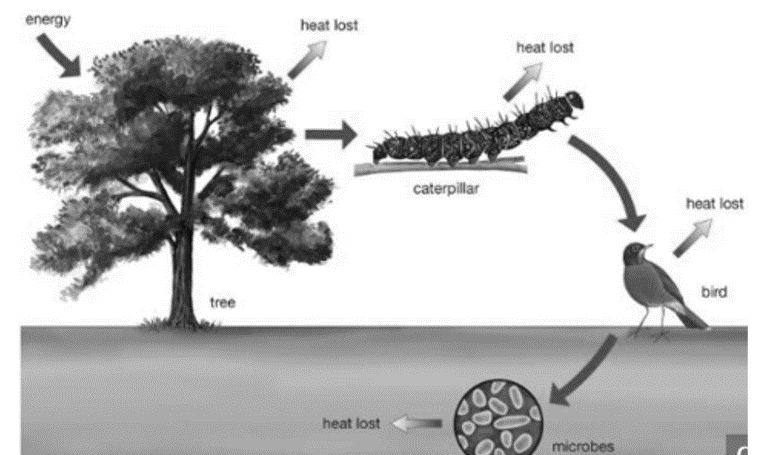
Fig 1: shows the energy transfer and heat loss along a food chain.
There are many types of ecosystems, but the three major classes of ecosystems, sometimes referred to as ‘biomes’, are the following:
Freshwater Ecosystems
They are further divided into smaller ecosystems.
Terrestrial Ecosystems
Terrestrial ecosystems have a wide variety of ecosystems as there exists a number of habitats on the earth some of the most common terrestrial ecosystems are:
Ocean Ecosystems
Ocean ecosystems are relatively contained, there are different types of ocean ecosystems:
Community ecology deals with two or more populations having different species that live in a particular geographical area. It also highlights how the community structure is changed by interactions among the organisms.
A community has the following characteristics:
(a) Structure:
Structure of this community is determined by the frequency density of the population and the presence of abundant species.
(b) Dominance:
In a community that has two or more population either of the populations will be in large numbers, such species will usually be the dominant ones, and hence the name.
(c) Diversity:
The community has a uniform environment where different groups of plants and animals of different species, which may be in large numbers or small, and may belong to a particular life form or the other.
(d) Periodicity:
In the dominant species of a community, the various life processes that take place like Th (respiration, growth, reproduction etc.) during various seasons of the year. The recurrence of these important life processes at regular intervals in a year and their manifestation in nature is termed periodicity.
(e) Stratification:
This is usually a division that occurs in plants. As the Natural forest communities possess a number of stores or layers or strata related to the height of plants, for example, smaller trees, tall trees, smaller trees, herbaceous layers andshrubs form the different strata. This phenomenon in a plant community is called stratification.
(j) Biotic Stability:
A biotic community has the ability to quickly regain equilibrium after a disturbance in population fluctuation. The diversity in a community interacting with the number of species is directly proportional to the biotic stability.
Biological spectrum.
Across the various levels of biological organisation, the biological spectrum consists of all living organisms that are divided into three domains. Based on common ancestors and history of the life forms based on RNA, Microbiologist Carl Woese organized all known organisms into three domains bacteria, archaea and eukaryota, which are further subdivided into kingdoms. All three domains exist on various levels of biological organization, from a cellular level to its biosphere.
The single cell is the structural and functional unit of life. Some organisms are single-cell, in which that single cell performs all the functions of life. Other organisms are multicellular and specialised cells that show a division of labour.The hierarchy of life is followed by the Multicellular organismsthat have a biological complexity. Tissue are noting but groups of cells working together to perform a specialized function. Two or more tissue types working together to perform a function form an organ. Organs cooperating together for a larger function form the organ system.
An individual form of life is a multicellular organism that is composed of multiple organ systems. Communities are populated with both multicellular and single-cell organisms, and this pattern of life inhabits a particular ecosystem. An ecosystem consists of all living organisms that interact together with a non-living environment in a particular area, all of life on Earth, and the places in which this life exists, is called the biosphere.
Ecosystem is a complex in which habitat, plants and animals are considered as one interesting unit, the materials and energy of one passing in and out of the others” – Woodbury.
A.G Tansley was the first to put forth the concept of ecosystem in 1935. Which he considered is the major ecological unit. The ecosystem has both structure and functions the structure is usually related to species diversity. If the structure of the ecosystems is complex greater will be the diversity related to species. The functions of ecosystem are howeverrelated to the cycling of the nutrients and flow of energy through structural components of the ecosystem.
Structure of Ecosystem:
It basically gives a description of the organism and its interaction with the environment that includes the amount and distribution of nutrients for a particular habitat. It also gives information regarding the range of climatic conditions that exists in the area.
From the structure point of view, all ecosystems consist of the following basic components:
1. Abiotic components
2. Biotic components
1. Abiotic Components:
Basic inorganic elements and compounds constitute the Abiotic component of ecosystem these compounds include water, soil, water, oxygen, phosphates and calcium carbonates, and a variety of organic compounds (by-products of organic activities or death).
It also includes physical factors and ingredients such asas moisture, solar radiation and wind currents. The energy from the sun is the only significant energy for any of the ecosystems, the non-living components, include nitrogen,carbon, phosphorus etc. that are present at any given time is known as standing state or standing quantity.
2. Biotic Components:
The biotic components for a given environment includes all living organisms. From nutrition point of view, the biotic components can be grouped into two basic components:
(i) The Autotrophic components, and
(ii) The Heterotrophic components
The autotrophic components are all green plants which utilise the radiant energy of sun and prepare food from inorganic substances. The heterotrophic components include non-green plants and all animals which depend on autotrophs for their food.
So biotic components of an ecosystem can be described under the following three heads:
1. Producers (Autotrophic components),
2. Consumers, and
3. Decomposers or reducers and transformers
Producers (Autotrophic elements):
The green plants are the producers are and also the autotrophic elements. During the process of Photosynthesis these green plants use radiant energy of sun wherein carbon dioxide is used to give out oxygen and the light energy is converted into chemical energy. The chemical energy is actually locked up in the energy rich carbon compounds called ATP. The by product that is evolved during photosynthesis is Oxygen.
The oxygen and ATP are used in Respiration process of all living beings. some examples of producers are Algae and other hydrophytes of a pond, grasses of the field, trees of the forests. They are also a special type of bacteria that perform photosynthesis in presence of sunlight and use carbon dioxide but only in the presence of organic compounds are Chemosynthetic bacteria and carotenoid bearing purple bacteria that are also characterised in this group. that also assimilate CO2 with the energy of sunlight but only in the presence of organic compounds also belong to this category
Consumers:
Those living members of ecosystem which consume the food synthesized by producers are called consumers. This categoryincludes various kinds of animals that are found in an ecosystem.
There are different classes or categories of consumers, such as:
(a) First order of consumers or the primary consumers,
(b) Second order of consumers or thesecondary consumers,
(c) The third order of Consumers or the tertiary consumers, and
(d) The last are saprobes, parasites and scavengers.
(a) Primary consumers:
This group of organismsare purely herbivorous animals that are dependent for their food on producers or green plants. They include deer, goat, cow, Insects, rodents, rabbit, deer,buffalo, are some of the common herbivores in the terrestrial ecosystem, and in aquatic ecosystems small crustaceans, molluscs, etc. are included. Elton (1939) derived the word “key industry animals” for the herbivores present in the ecosystem. The herbivores serve as the chief food source for carnivores.
(b) Secondary consumers:
This group includes both carnivores and omnivores. Carnivores are animals that are flesh eating animals and the omnivores are the animals that are able to consume herbivores as well as plants as their food. Examples of secondary consumers are crow, dogs, sparrow, fox, wolves, cats, snakes, etc.
(c) Tertiary consumers:
These are the top carnivores which prey upon other carnivores, omnivores and herbivores. Lions,hawks, leopards, tigers, eagle, vulture, etc. are considered as tertiary or top consumers.
(d) the parasites, saprobes and scavengers belong to a different class of consumers, the parasitic plants and animals utilize the living tissues of different plants and animals. The dead remains of others animals and plants are utilised by the scavengers and saprobes as their food.
Decomposers and transformers:
Decomposers and transformers play a crucial role in maintaining the dynamic nature of the ecosystem, they are the living components of the ecosystem and are namely fungi and bacteria. Decomposers attack the dead remains of consumers and producers and degrade the complex organic substances into simpler compounds. The simple organic compoundis then utilised by another kind of bacteria, the transformers which change these organic compounds into the inorganic forms that are suitable for reuse by producers or green plants. Thus, decomposers and transformer are important elements in the ecosystems.
Food chain, in ecology, refers to the sequence of elements that involve the transfers of d energy and matter in the form of food from oneorganism to another organism. Food webs are known to locally intermingle with Food chains as most organisms consume more than one type of animal or plant. The primary food source is from the plants which are able to convert energy from the sun into source of food Plants. The plant eating animals are eaten by the flesh-eating animals in a predatorchain however in a parasite chain, a smaller organism consumes part of a larger host and may itself be parasitized by even smaller organisms. In a saprophytic chain, microorganisms live on dead organic matter.
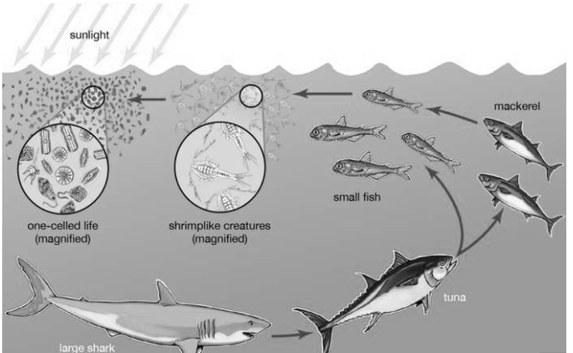
Fig: 2 The foundations of the ocean food chain are the Diatoms and other phytoplankton. Shrimplike krill consume the phytoplankton, and small fishes eat the krill. At the top of the food chain, dining on these smaller fishes, are larger, predatory fishes.
As energy, in the form of heat, is lost at each step of the food chain, or trophic level, foodchains do not normally contain more than four or five trophic levels. However, the amount can be increased by cutting one step of the food chain, for example instead of the animals consuming cereal grains, the people themselvescan consume the grains. subsequently the food chain can made shorter, and therefore the total amount of energy available to the final consumers is increased.
In a food web a number of unique interactions takes place and also relationships which are involved in the transportation of energy. The energy that is produced by the plants, is captured, and distributed throughout the various living organisms present at the various levels. This transfer of energy is termed as the food web.
It consists of a series of organisms related by predator-prey and consumer-resource interactions; the entirety of interrelated food chains in an ecological community.
A food web shows the overall food relationship that exist between the organism and their environment the food web is a detailed diagram that interconnectsthe organism and its environment. It shows who is eaten by whom and the complex feeding relationships in a particular ecosystem.
A food web is a diagram that shows in an ecological community, which animals eat which other animals. It also aims to show the transfer or flow of energy and materials, such as sunlight or carbon, that occurs between species through their feeding relationships.
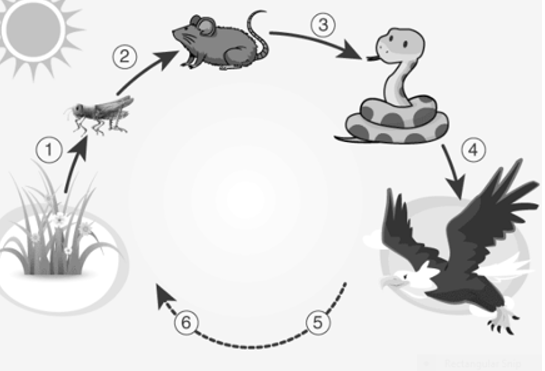
Fig: 3 shows a picture of a food web as to who eats whom, initially the grasshoppers eat the plants, mice eat the grasshoppers, snake eats the mice, eagle eats the snake. When these hawks or eagles die the fungi breaks down these bodies and turns it into nutrients finally the nutrient present in soil along with the sun and water help the plant to grow and the cycle continues.
10.6 Ecological pyramids
The Ecological pyramids was first introduced by Evelyne Hutchinson and Raymond Lindeman. The pyramidshows the graphical representation of the relationship between the different living organisms at different trophic levels.
When observed these ecological pyramids look very similar to the actual pyramids, the structure shows a broad base occupied by the producers then the next level is occupied by the consumers and so on.
In order to construct the Ecological pyramids, all the calculations are taken into account the organisms in a particular trophic level as ample space is occupied by a few numbers or a few species that results in huge level of errors.
Types of Ecological Pyramid
Three types of ecological pyramid. They are as follows:
Pyramid of Numbers
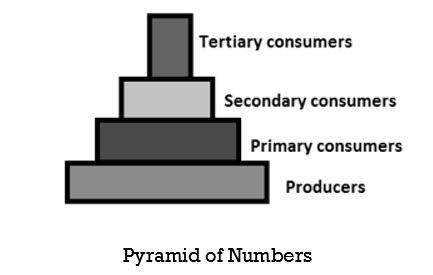
In this type of ecological pyramid, the pyramid is usually upright except at certain levels, at each level the totalnumber of organisms is considered as a level in the pyramid, where many organisms feed on one plant or animal as seen in the case of detritus food chain.
Pyramid of Biomass

Pyramid of Biomass
In this pyramid, the amount of biomass produced at each tropic level is taken into account. The pyramid of biomass is also upright except for that observed in large number of zooplanktons in oceans where they depend on a relatively smaller number of phytoplanktons.
Pyramid of Energy
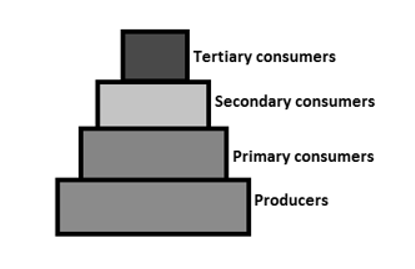
Pyramid of Energy
In the Ecological Pyramid the Pyramid of energy is the only type which is always upright and the flow of energy is always in one direction across all the levels, some energy is howeverlost into the environment.
Importance of Ecological Pyramid
The importance of ecological pyramid can be viewed in the following points:
References: